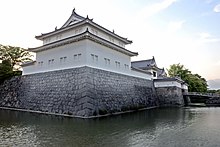Sunpu Domain

Sunpu Domain (駿府藩, Sunpu-han) was a Japanese feudal domain intermittently during the Edo period. It was centered in Suruga Province, in what is now the city of Shizuoka, but at times included Kai and parts of Tōtōmi Provinces. In 1869 the domain was renamed Shizuoka Domain (静岡藩).
History
During the Muromachi period, Sunpu was the capital of the Imagawa clan. The Imagawa were defeated at the Battle of Okehazama, and Sunpu was subsequently ruled by Takeda Shingen, followed by Tokugawa Ieyasu. However, Toyotomi Hideyoshi relocated Ieyasu, and installed Nakamura Kazutada to rule Sunpu. After the Toyotomi were defeated in the Battle of Sekigahara, Tokugawa Ieyasu recovered Sunpu and relocated Nakamura to Yonago in Hōki Province, reassigning it to his own retainer, Naitō Nobunari in 1601. This marked the start of Sunpu Domain.
In April 1606, Ieyasu officially retired from the post of Shogun, and retired to Sunpu, where he established a secondary court, from which he could influence Shogun Tokugawa Hidetada from behind the scenes. Naitō was transferred to Nagahama in Ōmi Province.
Sunpu Domain was briefly re-established in 1609 for Tokugawa Ieyasu's tenth son Tokugawa Yorinobu. It was disbanded in 1619 and reverted to tenryō status (direct administration by the Shogunate) when Yorinobu moved to Wakayama to found the Wakayama Domain.
In 1624, Sunpu Domain was again established, this time for Tokugawa Hidetada's third son Tokugawa Tadanaga, with assigned revenues of 500,000 koku. However, Tadanaga had an extreme enmity against his brother, Shogun Tokugawa Iemitsu, and a violent disposition. He was removed from office and forced to commit seppuku in December 1632, after which time Sunpu Domain came under the direct administration of the shogunate. Through the remainder of the Edo period, Sunpu was ruled by the Sunpu jōdai (駿府城代), an official with hatamoto status, appointed by the Tokugawa shogunate.
During the Meiji Restoration, the final Tokugawa Shogun, Tokugawa Yoshinobu resigned his office to Emperor Meiji and leadership of the Tokugawa clan to Tokugawa Iesato. In 1868, Iesato was demoted in status to that of an ordinary daimyo, and assigned the newly-created Shizuoka Domain, which included all of former Sunpu Domain, neighboring Tanaka and Ōjima Domains, and additional lands in Tōtōmi and Mutsu Provinces for a total revenue of 700,000 koku. The territories in Mutsu were exchanged for territories in Mikawa Province later that year. However, in 1869, the title of daimyo was abolished, and with the abolition of the han system in 1871, Shizuoka Domain itself was abolished.
The lands of the former Shizuoka Domain now form the western two-thirds of Shizuoka Prefecture, plus the Chita Peninsula in Aichi Prefecture.
List of daimyo
 Naitō clan (fudai) 1601–1613
Naitō clan (fudai) 1601–1613
| # | Name | Tenure | Courtesy title | Court Rank | revenues |
|---|---|---|---|---|---|
| 1 | Naitō Nobunari (内藤信成) | 1601–1606 | Bizen-no-kami | Lower 5th (従五位下) | 40,000 koku |
 Tokugawa clan (shimpan) 1609–1871
Tokugawa clan (shimpan) 1609–1871
| Name | Tenure | Courtesy title | Court Rank | revenues | |
|---|---|---|---|---|---|
| x | tenryō | 1608–1609 | |||
| 1 | Tokugawa Iesato (徳川家達) | 1609–1619 | Dainagon | 2nd (従二位) | 500,000 koku |
| x | tenryō | 1619–1625 | |||
| 1 | Tokugawa Tadanaga (徳川 忠長) | 1625–1634 | Dainagon | 2nd (従二位) | 500,000 koku |
| x | tenryō | 1634–1869 | |||
| 1 | Tokugawa Yoshinobu (徳川慶喜) | 1869–1871 | Sangi | 1st (従一位) | 700,000 koku |
References
- Shiba, Ryotaro. The Last Shogun: The Life of Tokugawa Yoshinobu. Kodansha America (1998). ISBN 1-56836-246-3
- Westin, Mark. Giants of Japan: The Lives of Japan's Most Influential Men and Women. Kodansha USA (2002). ISBN 1-56836-324-9
